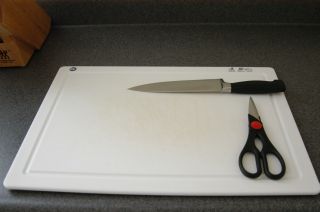 First, start with a clean surface and assemble your tools. All you really need is a strong sturdy knife and a large cutting board. I also like using kitchen or poultry shears. In the picture below, you'll see that I'm using a plastic cutting board, but wood would have worked just as well (see Equipment & Gear: Cutting Boards). In my case, my largest wood cutting board does not have a blood or juice groove, so I chose to use my large plastic board.
First, start with a clean surface and assemble your tools. All you really need is a strong sturdy knife and a large cutting board. I also like using kitchen or poultry shears. In the picture below, you'll see that I'm using a plastic cutting board, but wood would have worked just as well (see Equipment & Gear: Cutting Boards). In my case, my largest wood cutting board does not have a blood or juice groove, so I chose to use my large plastic board.Remove the giblets from the chicken and set aside (often, I'll use these and any trimmings from the bird for making stock). Rinse the chicken and as much water as possible drip out before transferring to the cutting board. Orient the carcass so the breast is facing up.
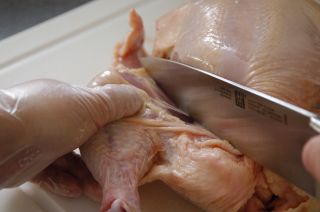 Start by removing the legs. This is done by pulling a leg away from the body and scraping with the sharp edge of the knife through the connecting skin and tissue.
Start by removing the legs. This is done by pulling a leg away from the body and scraping with the sharp edge of the knife through the connecting skin and tissue.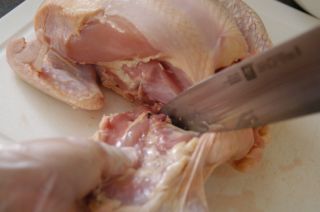 Once the bone is reached, use the tip of your knife to find the joint where the thigh meets the main body. Pressing down on the knife between the joint, cut through the cartilage and separate the leg from the body.
Once the bone is reached, use the tip of your knife to find the joint where the thigh meets the main body. Pressing down on the knife between the joint, cut through the cartilage and separate the leg from the body.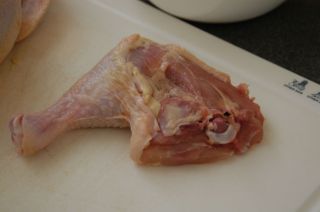 By cutting through the joint, you won't have any shattered pieces of bone in your chicken.
By cutting through the joint, you won't have any shattered pieces of bone in your chicken.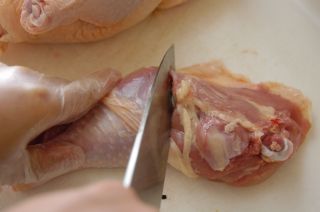 Use your fingers to feel where the thigh bone meets the drumstick and cut through the joint with your knife. Once you've separated the drumstick from the thigh, look to see where you started your cut. On the other leg, look at the same region. You'll notice a line of fat. Cutting straight down through this line will yield clean separation of drumstick and thigh.
Use your fingers to feel where the thigh bone meets the drumstick and cut through the joint with your knife. Once you've separated the drumstick from the thigh, look to see where you started your cut. On the other leg, look at the same region. You'll notice a line of fat. Cutting straight down through this line will yield clean separation of drumstick and thigh. Next, separate the wing from the body.
Next, separate the wing from the body.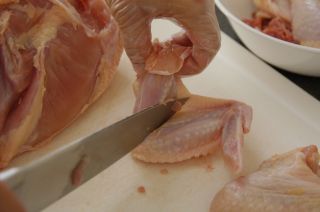 For a twelve piece chicken, cut the wing through the first joint. This cut is desirable when frying the chicken wings because it exposes more of the skin of the wing providing more area for breading and a more even fry. The wing portion with the tip is called a wingette, while the portion attached to the body is called the drummette.
For a twelve piece chicken, cut the wing through the first joint. This cut is desirable when frying the chicken wings because it exposes more of the skin of the wing providing more area for breading and a more even fry. The wing portion with the tip is called a wingette, while the portion attached to the body is called the drummette.Repeat the leg and wing steps for the other side.
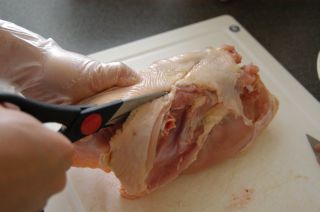 Rotate the carcass so it is breast-side down. Using kitchen shears, cut through the ribs down both sides of the back bone. If you don't have kitchen shears, you can stand the bird up and cut down with your knife to remove the backbone. You can save the backbone for making stock.
Rotate the carcass so it is breast-side down. Using kitchen shears, cut through the ribs down both sides of the back bone. If you don't have kitchen shears, you can stand the bird up and cut down with your knife to remove the backbone. You can save the backbone for making stock.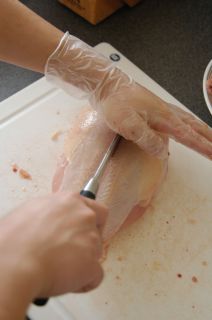 Splitting the breast can be done from the breast side, as shown below.
Splitting the breast can be done from the breast side, as shown below.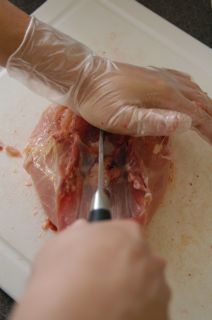 Another method is to split the breast by cutting from the inside, through the keel bone.
Another method is to split the breast by cutting from the inside, through the keel bone.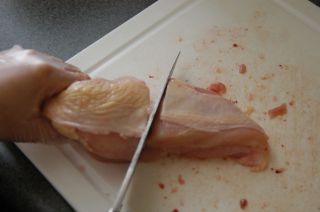 Once the breasts have been separated, you can cut them in half for a ten or twelve piece chicken. This is often recommended to produce portions of similar size - especially since many chickens are bred to have large breasts.
Once the breasts have been separated, you can cut them in half for a ten or twelve piece chicken. This is often recommended to produce portions of similar size - especially since many chickens are bred to have large breasts.This method of cutting up a chicken can produce the "classic" eight piece, even-portioned ten piece, or perfect-fry twelve piece cuts.
Eight pieces
- 2 drumsticks
- 2 thighs
- 2 wings
- 2 breast halves
Ten pieces
- 2 drumsticks
- 2 thighs
- 2 wings
- 4 breast quarters
Twelve pieces
- 2 drumsticks
- 2 thighs
- 2 wingettes
- 2 drummettes
- 4 breast quarters
Tools used:
- Kitchen shears to cut backbone off
- Chef's knife to section chicken
- Boning knife is a great alternative for the Chef's knife for everything except cutting through the keel bone. A sharp boning knife will remove the wings and legs from body easily and since you are cutting through the joints and not bones, the thin blade gives great speed and flexibility.

I stumbled over your site, weirdly enough, looking for an answer to a question about the way graphics are displaying in my Word document.
At any rate, great site. Thought I'd point you to DC-stuff's Cookbook. It's a collection of recipes from participants in a forum for people who attend Defcon -- the yearly hacker convention in Vegas.
Great recipes there and great commentary about how to enjoy wine, food, beer, scotch, and other delights!
I post at the list every so often and couldn't resist sharing with a fellow geek/gourmet! :)
http://www.reeza.com/c00kb00k/
I had always learned to remove the keel bone before splitting the breasts, and I think a boning knife would be handy here.
That's another article... a sharp boning knife is very handy for extracting bones from the dark meat. Deboning a breast is pretty straight forward - but knowing the technique helps a lot (like cutting up the chicken).
I'd love to see an article about deboning.
-snekse
Did that influence you to post this? :D
It turns out the very first episode of Good Eats I ever saw (a couple years ago) was Fry Hard II where Alton uses a T-Rex dinosaur model to show how to cut up a whole chicken. I was hooked from that moment on.
The impetus to post this article? Maybe my subconscious remembered Fry Hard II, but I my conscious thought process was: Hmm, I've been frying a whole lot of chickens (testing fried chicken recipes) and today whole chickens went are on sale... I should do a pictoral on cutting up a chicken.
If I remember correctly, Alton's method results in boneless breasts and an intact wishbone.
Love this site!
Great tip, mopalia! Thanks!
Possibly a Britishism? Anyways it's a great way to cut a bird for grilling.
I think we just call it: butterflied chicken
This typically involves removing the backbone and spreading the chicken out while pressing down on the breastplate until it breaks. Some grilling methods use skewers through the bird to hold it in position.
My stock recipe is at:
http://www.cookingforengineers.com/article.php?id=75
I added links to the article within this one. Thanks!
We butterfly turkeys at our house, then cook on the gas grill. I saw the technique on a PBS show, but they cooked their bird in the oven. When the bird is brined first and cooked pretty fast, this yields the juiciest turkey.
It is perfect since I always struggle against thighs... However, is it the same technic when the chicken is roasted? Thanks a lot!!!
The technique is similar, but you deal with the breast a little differently. I have a pictoral attached tot he bottom of the Classic Roast Turkey recipe at
http://www.cookingforengineers.com/article.php?id=74
Is there a specific name for the knife shown, as in deboning knife ?
Want to get a good reputable knife. Any suggestions ?
Thanks
The knife used in this pictoral is an 8 in. Chef's knife. I chose this knife because I was able to effectively work dextrously with it while still having the ability to push through bones when I needed to. A boning knife would give you a great deal more control, but is not useful when trying to cut through the keel bone.
We'll use a boning knife for preparing a boneless chicken.
I've added some comments to the article on what instruments were used in this procedure.
As I mentioned in the Cutting Boards article, wood butting boards do not harbor bacteria. In fact, most kitchens have cleaner wood cutting baords than plastic because home chef's do not replace their plastic cutting boards often enough.
Conventional wisdom states that because you cut grooves into wood cutting boards, bacteria can be trapped in those micro-grooves allowing rampant growth of germs. This is true, but a thorough scrubbing will clean out all large particles and as the wood dries, the wood naturally becomes a hostile environment killing any surface bacteria and drawing the rest deep into the board (away from the surface).
Plastic boards on the other hand will develop small grooves from cuts and these won't "heal" (soften to form a continuous surface). The bacteria is much harder to get out even with severe scrubbing. Plastic cutting boards that have touched meast or poultry should go through a dishwasher cycle to heat kill the bacteria since washing and drying does not have the germicidal effect of wood boards. Also, once the board has developed too many grooves, the board should be replaced.
Link to Equipment & Gear: Cutting Boards
Martin uses a Chinese cleaver, Jacques uses a chef's knife. They both go like lightening.
It's probably scary to watch, as well as a amazing. Shows what just a little practice will get you...
RE: cutting up chicken...if your look carefully at the joints you will see a fine line of fat which appears as a thin white strip under the skin. Cut through this line of fat and you hit the joint each time. It's visible on every joint you cut.
I grap the chick leg with my left hand and the rest of the chicken by my right hand so that my thumbs towards each other (almost like vectors). I can easily determine where the joint based on the way the legs can rotate. The place where my two thumbs eventually lined up where there is a slight depression between. There's where I make my cut.
M. Brook
I ran across you site looking for tips on "Deboning" chicken wings. There are several Thai recipes, and one from Emerl on foodtv.com for Stuffed chicken wings that I really want to try.
I have downloaded two techniques - emerls and one other, and have tried to debone the wings. I can get the bones out, but It seems like I should wind up with a skin "sock" with meat in the middle. and my boned wings wind up looking like rags...
Help!
donw
Thats a pretty wide question mr.
Do you mean a formal education???
One area for improvement is the wing. You need to cut off the tip of the wing and not seperate the wing from the drumette. You do this since the tip has no savory meat for the consumer.
The other area is the breast. You demonstrated the way to leave the bone in the breats. The other method is to debone the breast. This is done using hte filet knife and using a skinning motion run the knife between the bone and the flesh pulling the flesh as you cut along the carcass.
thanx, Lorene
explains most of that
We are now raising our own backyard flock of heritage breed chickens for meat and eggs. We won't get the rapid growth (the youngest our birds will be harvested is 16 weeks) or the enormous breast, but then, our chooks will be able to live much more normal chicken lives, running, scratching, sunbathing, catching bugs, and roosting in trees. For our money, it's a pretty good trade-off.
Thanks for these posts, BTW. We'll be referring to them when we dress out our birds, since we rarely roast one whole or eat the skin.
>>>I'm pretty sure green tenders are tissue that's gone necrotic.
see a search on: Deep Pectoral Myopathy
as applied to a living animal, necrotic means dead and rotting tissue.
I would not eat any of that chicken and - being it's a repeat performance - I'd sure be looking for another source of chicken.
appears to be more prevalent in large birds - especially bred for breast meat production.
I'd also pack it up, take it into the store manager and ask if they'd care for a bite . . .
Jon
kidding!! Threw it all out!
I have seen it before- cornish cross - large birds.
From now on when the bird is thawed I will be cutting along the breast bone to inspect before roasting.
Sometimes the large birds have few feathers on the breast as they lay down a lot. they can have a scab there - Possible entry point for bacteria?
Supper was mashed potatoes, salad, fresh biscuits, stuffing- the extra that was not inside the bird, gravey- wine- was all good
unfortunately, worse.
overly large breast development leads to tissue necrosis / myopathy.
more here:
ps.fass.org/content/85/10/1843.full
open the link for pdf full text version.
the bird cannot supply enough blood to the huge breast sections and the tissue dies.
some articles cite it is safe for human consumption.
quite frankly, I'm not going to eat chicken meat that the chicken has been carrying around dead and decaying within its body.
ymmv.
once you come to picture 9 (splitting the bone), don't split the bone, just remove the skin and make a neat slice with the knife all the way down the middle, and stick your finger underneath the slit, you'll find that the breast comes off the bone very easily - one on the right side, and one on the left - just use your knife to ease it off from the sides.
(i bang the breasts with a 'schnitzel hammer', i dip into bread crumbs, then into beaten egg and again into bread crumbs and fry! yum the children [and grown ups] love it)